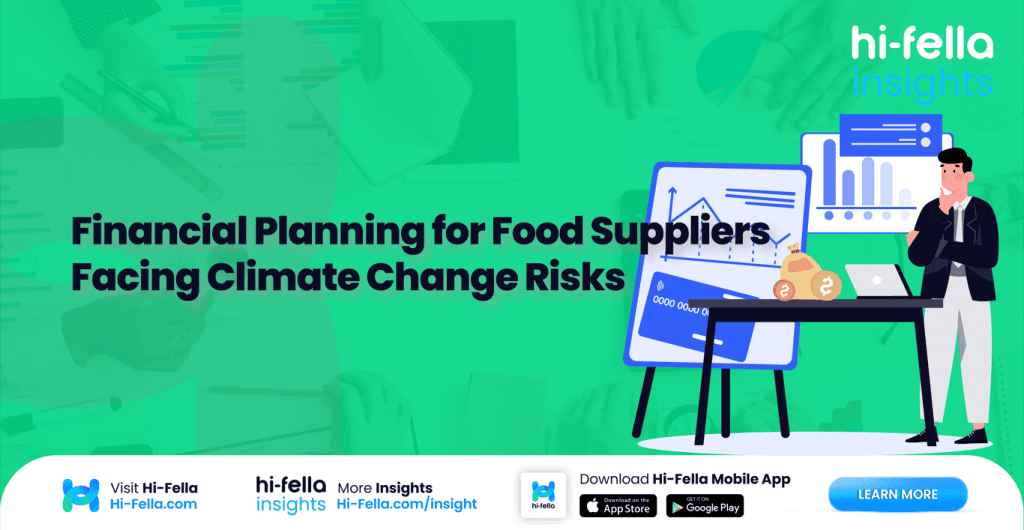Food suppliers have always danced with risk. But now the tempo’s changing—and climate change is calling the tune. Shifting weather patterns, rising temperatures, unpredictable rainfall, floods, droughts, and supply chain disruptions are no longer hypotheticals. They’re financial realities.
If you’re in the food supply game and you’re not rethinking your financial strategy in light of climate change, you’re not just behind—you’re exposed. This is where financial planning stops being a spreadsheet exercise and starts becoming a survival strategy.
Let’s unpack how food suppliers can smartly plan, adapt, and stay financially viable in an era of climate uncertainty.
Identifying Climate-Related Financial Risks
First things first: you can’t manage what you don’t understand. Climate change introduces several categories of financial risks for food suppliers.
Physical risks include direct damage to crops, raw materials, warehouses, or transportation due to floods, storms, and temperature extremes. This hits both your bottom line and your supply reliability.
Transition risks involve the costs of adapting to new regulations, shifting to sustainable practices, or updating infrastructure. These aren’t optional—they’re coming whether you’re ready or not.
Then there’s market risk—consumer behaviour is changing. Demand for sustainable sourcing, climate-conscious products, and transparent supply chains is rising. If you’re not aligned, you risk losing relevance.
Building a Resilient Cash Flow Strategy
One of the most underrated tools in climate resilience? Cash flow. Food suppliers need tighter control over their working capital to absorb shocks. This means building flexibility into your operating budget—creating buffers for things like unexpected weather-related yield losses, transportation delays, or regulatory fines.
Think about staggering your payments, renegotiating supplier terms, and diversifying income streams (e.g., by offering value-added services like cold chain logistics or traceability systems). The goal is to avoid becoming overly dependent on one crop, one season, or one distribution channel.
Smart financial planning isn’t just about surviving a bad season. It’s about having enough agility to pivot when the climate does.
Diversifying Supply Chains and Geographies
Overconcentration is a liability. If all your suppliers are in one region that’s vulnerable to drought—or if your logistics depend on a single port that floods every monsoon season—you’re gambling with your margins.
Financially speaking, this is a risk you can price. Insurers do it. Investors do it. And food suppliers need to do it too. Diversify your supplier base across multiple geographies. Invest in data systems that let you monitor supply conditions in real time. Build relationships with multiple growers and producers.
If one link in your chain goes down, your business doesn’t have to.
Climate-Proofing Your Capital Investments
Capital expenditure used to be about scaling production. Now, it’s about building climate resilience into your infrastructure. Think: heat-tolerant storage facilities, water-efficient irrigation systems, renewable energy, and robust temperature-controlled logistics.
Sure, these upgrades require upfront investment—but they’re not expenses, they’re hedges against long-term loss. Financial planning should model the ROI not just in years, but in disruptions avoided and downtime prevented.
And don’t overlook financing options. Governments and private funds are increasingly offering green financing, climate bonds, and sustainability-linked loans. If you align your upgrades with ESG criteria, capital becomes more accessible—and cheaper.
Leveraging Insurance and Financial Instruments
Let’s talk risk transfer. Insurance isn’t just for peace of mind—it’s a core financial planning tool in a climate-volatile industry.
Crop insurance, weather-indexed coverage, and business interruption insurance are critical. Some insurance models now use satellite and climate data to offer dynamic policies. Yes, the premiums might feel steep, but the alternative—uninsured climate impact—can be catastrophic.
In some markets, forward contracts and derivatives can also help suppliers lock in prices and protect against volatility. That’s especially valuable when extreme weather impacts harvest quality and leads to commodity price spikes.
Scenario Planning and Stress Testing
Financial planning under climate risk isn’t just about what happens—it’s about what could happen. Scenario planning helps you model different futures: What if there’s a 20% crop loss due to heatwaves? What if your cold chain breaks during a blackout? What if water costs triple in five years?
Run the numbers. Stress test your assumptions. Adjust your financial models to reflect realistic, climate-informed scenarios—not best-case fantasies.
This also helps when talking to investors and lenders. Nothing says “we’re future-proof” like a business that has modelled risk, built contingencies, and shown how it would remain solvent under pressure.
Aligning with ESG and Investor Expectations
Investors aren’t just asking for financial performance anymore. They want climate responsibility, traceability, and ESG metrics. That’s not fluff—it’s shaping access to funding.
Food suppliers with a clear financial plan that includes climate mitigation, emissions reductions, and sustainable sourcing are better positioned to attract capital. Bonus: ESG-conscious strategies often reduce long-term operational costs too.
In a nutshell: climate risk management and capital access are becoming two sides of the same coin.
Financial Collaboration with Climate-Focused Partners
You don’t have to go it alone. Strategic partnerships with agritech firms, sustainability consultants, fintech platforms, and even competitors can help spread risk and reduce costs.
Pooling logistics with neighbouring food suppliers, investing in joint warehousing, or even co-financing renewable energy infrastructure are all options that make financial sense in a climate-challenged world.
Also, tech platforms now offer climate risk analytics, crop monitoring, and automated financial alerts to help suppliers stay ahead of both weather and wallet issues. Integrating this kind of intelligence into your financial planning is just smart business.
Future-Proofing Starts with Financial Discipline
The food supply industry is standing on shifting ground—literally and figuratively. But with the right financial planning, food suppliers don’t just survive the climate crisis—they navigate it profitably.
This means rethinking risk, embracing climate data, diversifying income streams, investing in resilience, and aligning with the big financial picture of a changing world. It’s not just about crops and contracts anymore—it’s about creating a model that bends without breaking.
Case Study: Financial Risk Planning for a Mid-Sized Produce Supplier in Southeast Asia
Let’s get practical. Imagine a mid-sized fresh produce supplier operating in Malaysia. They work with a network of smallholder farmers and distribute fruits and vegetables to urban supermarkets and online grocery platforms. Over the last five years, they’ve seen increasing climate volatility—early monsoons, prolonged droughts, flash floods—all of which have disrupted their sourcing and delivery schedules.
To stay ahead, they initiated a climate-integrated financial plan with the following steps:
1. Climate Risk Mapping
They identified vulnerable points in their supply chain—specific regions that were most affected by rainfall unpredictability and temperature spikes. Using satellite data and local meteorological reports, they created a vulnerability heatmap tied to their supplier regions.
2. Buffering Operational Cash Flow
Rather than running razor-thin margins, they built a 6-month cash reserve based on historical revenue dips during climate disruptions. They also diversified their bank lines to ensure short-term liquidity during unexpected procurement cost hikes.
3. Index-Based Crop Insurance
They worked with an insurance partner offering index-based policies tied to rainfall thresholds. If rainfall dropped below a certain level during planting season, they received automatic payouts—no claim paperwork, just data-triggered support. It wasn’t cheap, but it insulated them from major crop failure costs.
4. Strategic Supplier Diversification
To avoid overreliance on flood-prone zones, they onboarded new growers in higher elevation regions. Financial projections showed a 10–12% increase in logistics costs, but their scenario analysis revealed a potential 25% loss if primary suppliers failed.
5. Climate-Smart CapEx Planning
They installed solar-powered cold rooms at their key aggregation centres. The upfront cost was high, but the ROI became clear when grid power outages during floods no longer spoiled inventory. They financed it through a green loan with reduced interest, tied to ESG milestones.
6. Real-Time Financial Monitoring
They adopted a fintech dashboard that integrated climate alerts with procurement and delivery costs. So if a storm alert hit one of their supply regions, the finance team would immediately see its projected impact on margin, transport cost, and fulfilment risk.
The result? Their gross margins stabilised even as regional competitors struggled. Investors took notice of the risk management strategy, and the company secured a second round of sustainable investment funding.
Takeaway: This isn’t about weathering the storm. It’s about building a system that knows when the storm is coming, how hard it’ll hit—and what to do financially when it does.
Ready to Level Up?
If you’re in the food supply industry and climate change feels like a threat to your financial future, here’s the truth: you don’t need to panic—you need a smarter plan.
That’s where hi-fella comes in. Whether you’re looking to explore climate finance tools, automate your cash flow projections, or find expert collaborators who speak your language (and understand your margins), hi-fella is the platform that bridges insight with action. Let’s build a future where food systems—and your finances—can thrive under pressure.








